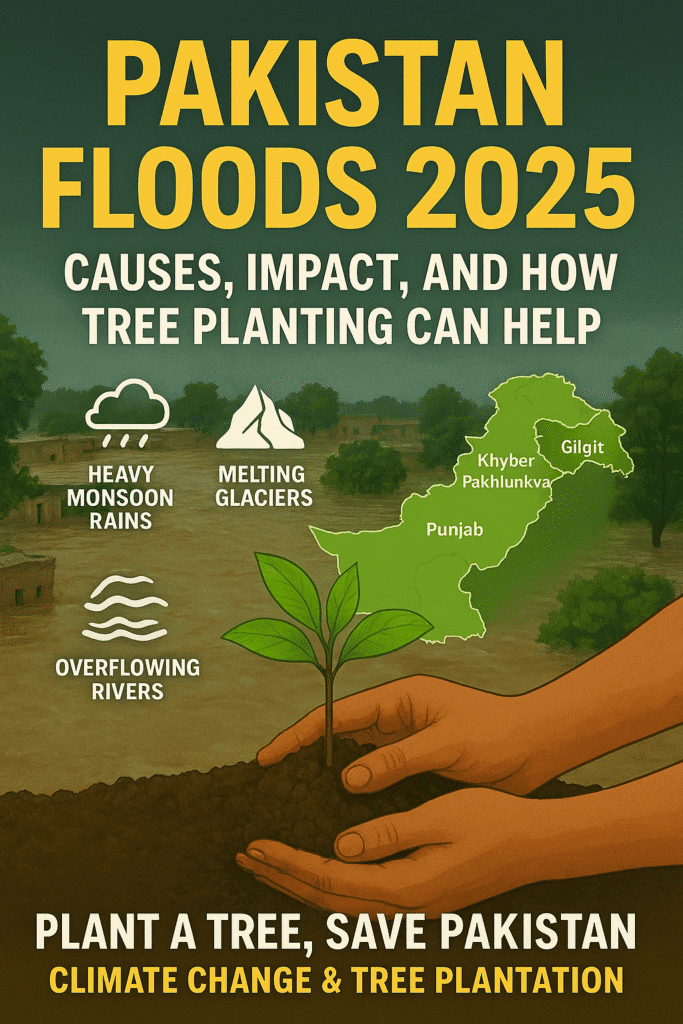The 2025 floods in Pakistan are some of the worst the country has ever faced. Heavy monsoon rains, melting glaciers, and overflowing rivers have swept through cities and villages, destroying homes, crops, and lives.
This is a clear sign of climate change — and it’s becoming more serious every year.
But there is hope. Planting trees may seem small, but it is one of the best ways to protect our communities and reduce the risk of future floods.
In this post, we will explain what caused the floods, which areas were most affected, and how planting trees can make a difference.

What Caused the Pakistan Floods in 2025?
Climate change is making Pakistan’s weather more extreme. Here are the main reasons for the floods:
Heavy Monsoon Rains
Warmer air holds more water, leading to heavier rainfalls. Karachi experienced 180 mm of rain in just one day this year, which caused many deaths and damage.
Melting Glaciers
Rising temperatures have melted glaciers faster than before. In Gilgit-Baltistan, this caused sudden glacial lake floods that killed dozens of people.
Overflowing Rivers
Rivers such as the Sutlej and Ravi overflowed, flooding large areas of farmland in Punjab.
Even though Pakistan produces less than 1% of the world’s carbon emissions, it is among the top 10 countries most vulnerable to climate disasters. This shows how unfair the effects of climate change are, and why we must take urgent action.
Which Areas Were Hit the Hardest?
Flooding affected every province, but some suffered more:
Khyber Pakhtunkhwa
- Over 450 people died, with 250 in Buner District.
- Roads, bridges, and homes were destroyed in Swat, Bajaur, and Charsadda.
- Landslides blocked access to remote villages, making rescue difficult.
Punjab
- More than 1 million acres of crops were ruined.
- Large evacuations took place in Kasur, Multan, and Vehari — over 2 million people affected.
- Cities like Lahore and Rawalpindi faced heavy urban flooding.
Sindh
- Entire villages in Sukkur, Dadu, and Larkana were flooded.
- Karachi had 180 mm of rain in a single day.
- Floodwaters spread diseases like cholera.
Gilgit-Baltistan
- Glacier floods cut off remote communities.
- At least 50 people died from sudden flooding.
How Bad Is the Damage?
The flood damage is serious:
- More than 1,000 people lost their lives.
- Over 10,000 homes were damaged or destroyed.
- Around 2 million acres of crops and 700,000 animals were lost, causing food shortages.
- At least 500,000 people lack clean water, and diseases like malaria and dengue are spreading.
How Can Planting Trees Help?
Planting trees might seem small, but trees do a lot to fight climate change and reduce floods:
- Trees absorb rainwater, which helps stop flooding.
- Their roots hold soil in place, preventing erosion.
- Trees take in carbon dioxide, helping cool the planet.
- Trees near rivers slow water flow and protect riverbanks.
- For farmers, trees improve soil health and provide shade for crops.
Since 2000, Pakistan has lost about one-third of its forests. If we don’t act now, future floods will become even worse.
How You Can Help: Start by Planting a Tree
Here’s how to get started:
- Choose local trees like neem, mango, banyan, or sheesham.
- Find a place to plant — your yard, school, park, or near rivers.
- Plant the tree properly — dig a hole, water it, and add mulch.
- Take care of the tree — water it regularly and protect it.
- Invite others to join or organize a tree-planting event.
Pakistan plans to plant 1 billion trees by 2030. Every tree counts
How Else Can You Help?
You don’t need to be an expert to make a difference. You can:
- Plant a tree — even one helps.
- Donate to trusted relief groups like Edhi Foundation, Red Crescent, or UNICEF.
- Volunteer with local flood relief or tree-planting programs.
- Spread awareness — talk about climate change and share reliable information.
Stay Safe and Act Now
If you live in a flood-prone area:
- Follow updates from NDMA or PDMA.
- Avoid flooded roads and unstable bridges.
- Keep an emergency bag ready with water, food, flashlight, and first aid.
For everyone:
Plant a tree. Talk to your community. Take action.
This is not just about the floods in 2025, it’s about creating a safer, greener future for all of us.
Climate change is real. But so is the solution. It starts with one tree.

Leave a Reply